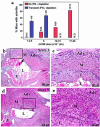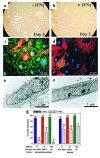IFN-gamma action in the media of the great elastic arteries, a novel immunoprivileged site
- PMID: 11160143
- PMCID: PMC199178
- DOI: 10.1172/JCI11540
IFN-gamma action in the media of the great elastic arteries, a novel immunoprivileged site
Abstract
Infection of medial smooth muscle cells with gamma-herpesvirus 68 (gammaHV68) causes severe chronic vasculitis that is restricted to the great elastic arteries. We show here that persistence of disease in the great elastic arteries is (a) due to inefficient clearance of viral infection from this site compared with other organs or other vascular sites, and (b) associated with failure of T cells and macrophages to enter the virus-infected elastic media. These findings demonstrate immunoprivilege of the media of the great elastic arteries. We found that IFN-gamma acted on somatic cells during acute infection to prevent the establishment of medial infection and on hematopoietic cells to determine the severity of disease in this site. The immunoprivileged elastic media may provide a site for persistence of pathogens or self antigens leading to chronic vascular disease, a process regulated by IFN-gamma actions on both somatic and hematopoietic cells. These concepts have significant implications for understanding immune responses contributing to or controlling chronic inflammatory diseases of the great vessels.
Figures






References
-
- Weck KE, et al. Murine gammaherpesvirus 68 causes large vessel arteritis in mice lacking interferon-gamma responsiveness: a new model for virus induced vascular disease. Nat Med. 1997;3:1346–1353. - PubMed
-
- Alber DG, Powell KL, Vallance P, Goodwin DA, Grahame-Clarke C. Herpesvirus infection accelerates atherosclerosis in the apolipoprotein E-deficient mouse. Circulation. 2000;102:779–785. - PubMed
Publication types
MeSH terms
Substances
Grants and funding
LinkOut - more resources
Full Text Sources
Other Literature Sources
Medical
Molecular Biology Databases

